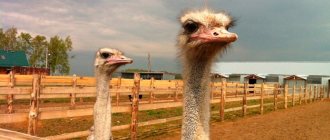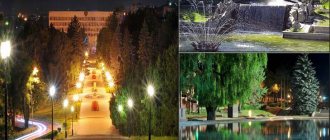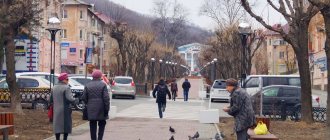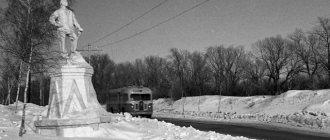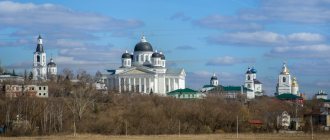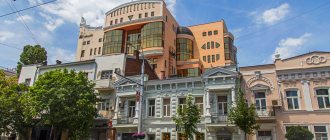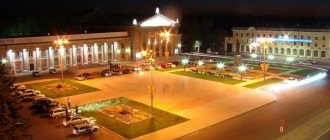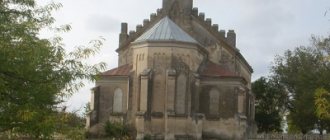Yalutorovsk is a city in the Tyumen region, located 85 km southeast of Tyumen.
- Starting from the 14th century, the Tatar settlement of Yavlu-Tur was located on the site of the modern city.
- In 1659, the Yalutorovsky fort was founded, designed to protect the approaches to Tyumen and Tobolsk from Central Asia.
- In 1782, Yalutorovsk received the status of a city with an established coat of arms.
- In the 18th century, such Decembrists as Obolensky, Pushchin, Cherkasov, Basargin and others were held in the city as exiles. During this period, Yalutorovsk became a center of trade, handicrafts and small industry in the region.
Today Yalutorovsk is an important transport hub of Western Siberia; the main industry of the city is the processing of agricultural products from the entire Tyumen region.
The population of the city is 40 thousand people.
Yalutorovsk: TOP-3 things to see in 1 day
On the first day of the tour, guests of Yalutorovsk should pay attention to the most popular and interesting sights of the city, which made it famous throughout the Tyumen region.
Museum complex "Yalutorovo prison"
- Address: Sretenskaya Square, 1.
By visiting the Yalutorovsky fort, tourists get the opportunity to see the city as it was in the first years of its existence. It was from this fortress that Yalutorovsk began to develop in 1659.
The modern complex is an exact copy of the ancient fort, built in 2009. The architects worked according to ancient drawings and folk technologies, thanks to which they were able to recreate the atmosphere of ancient Rus'.
The museum complex includes several buildings:
- Observation tower. The excursion begins from here. The observation tower allowed the sentinel to spot the enemy from afar. Today it is an observation deck from where you can see the entire fort.
- Huts. Each hut is a small museum. In one you can see the everyday furnishings of a peasant home from the mid-17th century, in the other - a torture chamber, etc.
- Forge. Here you can not only examine the forged items discovered at the excavation site of the old fort, but also see with your own eyes how a blacksmith works.
- Workshops with exhibitions of woven, ceramic, wickerwork, as well as folk dolls and Siberian wood painting.
In addition to architectural objects, there are decorative sculptures on the territory of the fort. The most interesting of them is “Snake Gorynych”. In its clawed paws it holds a pot of pilaf or soup. The food is cooked in the oven, and then the pot is transferred to the air and “given” to Gorynych.
“Snake Gorynych” was made by a local master in the same way as “Samovar”. The volume of the samovar is 150 liters. On Maslenitsa he provides hot tea to all guests of the prison. At the same time, tourists are treated to a three-meter pancake.
Not only excursions are organized in the Yalutorovsky prison. Master classes, folk festivals and costume photo shoots are regularly held here.
Decembrists Square
- Address: per. Railway.
The square dedicated to the memory of the exiled Decembrists is one of the most memorable sights of the city. In its center rises a stele in the form of swords pointing upward, holding hands in chains.
The famous lines of the poet A. Odoevsky are engraved on the pedestal of the stele: “Our hands rushed to the swords, but only found shackles.” Behind the stele, in a semicircle, are nine busts of the Decembrists who served exile in Yalutorovsk.
Sretensky Cathedral
- Address: Sretenskaya Square, 1.
Sretensky Cathedral was built in the first half of the 19th century and became the most beautiful temple in Siberia at that time. A magnificent building in the Siberian Baroque style adorned the banks of the Tobol River. The church was crowned with six golden domes, and the four-tiered bell tower pierced the clouds with a sharp spire. The decor of the facades consisted of stucco platbands, medallions and figured pediments.
However, the contractors made a mistake in construction, and in 1903 the first cracks appeared in the vaults. The building fell into disrepair in 1931, when the temple was already closed, and a youth club operated in it. The historic building was dismantled into bricks.
Restoration of the temple began in 2003. Six years later, the Sretensky Cathedral reopened its doors, and the bells on its bell tower came to life. Currently, the revived cathedral is a historical and architectural monument. His appearance has been recreated virtually unchanged.
Don't miss: Sights of the Tyumen region
Sights of Yalutorovsk
The main attraction of the city is the recreated Yalutorovsky fort . This popular tourist site was built in 2009 as part of the celebration of the 350th anniversary of Yalutorovsk. They tried to make it as close as possible to the historical original; they built it according to the plan preserved in the archives.
The prison is surrounded by a high wooden fence. There is a road tower and three watchtowers. On the territory there is a manor of the first settler, a barn, a forge, a crane well, and a dungeon. The dungeon features an archaeological exhibition, a torture room, an office, and an armory. In the barn you can see household items and tools.
There are observation decks, a shooting range, a tea room, an exhibition hall, a souvenir shop, and craft workshops (patchwork, carpet weaving, pottery, wicker weaving and wood painting). On the territory there are carved wooden sculptures, swings, and carousels.
Excursions, master classes, wedding ceremonies, as well as holidays and festivals “Siberian Maslenitsa”, “Cabbage Lady”, “August Spas”, “Singing Summer in Prison”, “Red Hill”, “Kvass Feast for the Whole World” are held here ", Santa Claus festival and others. During the New Year holidays, the residence of Father Frost operates here.
Contacts of the Yalutorovsky prison: website https://ostrog-yal.ru, tel. (34535) 2-05-95, 2-02-83.
In front of the fort is Sretenskaya Square . A square has been created here, in which there are memorial signs with the dates of the main events in the history of the city, and there is also a stele in honor of the founding of Yalutorovsk.
There is also a memorial sign on the square in honor of the founding of the city in the form of the figure of the patron saint of small towns, Nikola Mozhaisky. It was created by sculptor V.N. Sharapov. Another monument is dedicated to the victims of the kulak-SR rebellion of 1921.
Sretensky Cathedral standing here . It was built in 1837 in the Russian provincial baroque style. It was two-story, with six chapters. The height of the four-tiered bell tower with a spire reached 35 m. The unusual iconostasis of the Sretensky Cathedral, more than 11 m high, was considered a work of church art, made, as researchers suggest, by the best masters of Moscow and St. Petersburg in the Baroque style.
In 1837, during a visit to Yalutorovsk, the cathedral was visited by the future Emperor Alexander II. And in 1846, the Decembrist, Pushchin’s comrade-in-arms, Prince Evgeny Obolensky, married the former serf Varvara Baranova here. In 1908, the cathedral was closed due to cracks that appeared as a result of an error when laying the foundation. Repairs proceeded slowly; the cathedral was opened only before the First World War.
At the end of the 1920s the church was closed. A youth club was located in the building. In 1931, the building of the former cathedral was blown up. The bricks were used to build the House of Culture and a bathhouse, and the remaining construction waste was used to pave the streets. In the 2000s, they decided to rebuild the Sretensky Cathedral. It was opened for the 350th anniversary of Yalutorovsk in 2009.
The museums of Yalutorovsk are also interesting . In 1927, a local history museum (Revolution St., 75, tel. (34535) 2–01–94, 3–16–58). It tells about the history of the city from its founding to the present day. In front of the entrance there is a bust of the first director of the museum I.Yu. Ozolina. The museum is located in a two-story building built in the 1970s.
Nearby there is a wooden building of the Historical and Memorial Museum of the Yalutorovsky Museum Complex . It is located in a house built in 1795, in which the Decembrist, hero of the Patriotic War of 1812, M.I., Muravyov-Apostol . In 1935, while repairing the stove at home, the director of the local history museum I.Yu. Ozolin found a letter from M.I. sealed in a bottle. Muravyov-Apostol. In his message, he briefly described the history of the house, listed its inhabitants and ended with the words: “For the benefit and pleasure of future archaeologists, to whom I wish all the best in the world, I am placing this note on August 18, 1849.” This find served as the basis for the creation of the first museum in the USSR in Memory of the Decembrists. The letter can be seen among the museum exhibits. Three rooms in the house are memorial rooms - the hall, the owner's office and the living room. The museum's exhibitions tell about the Patriotic War of 1812, about the life and work of the Decembrists.
If you enter the fence, you will see a small two-story wooden house of the Decembrist I.D. Yakushkina . It was built at the turn of the 18th-19th centuries and belonged to the bourgeois woman F.R. Trapeznikova. The house was moved to the museum grounds in the 1950s. The house was cut down from a large pine forest like an old five-walled one, covered with a high plank roof “cap”. Yakushkin lived in this house for 18 years. On the first floor there is an exhibition “Philistine Interior of the 19th Century”, and on the second floor the dwelling of Ivan Dmitrievich Yakushkin is recreated. Memorial houses of M.I. Muravyov-Apostol and I.D. Yakushkin are monuments of historical and cultural heritage of federal significance.
Nearby, in the former mansion of merchant S.K. the House of Nature museum was opened in 2000 (Revolution St., 54, tel. (34535) 3–25–58). The museum includes the exhibitions “Traces of Past Eras” (finds from the floodplain of the Tobol River), “Predators of Our Forests”, “Inhabitants of Reservoirs”, “Village Heap”, as well as an open-air exhibition “Ecological Yard”.
In 2022, another museum opened in Yalutorovsk - “Trading Rows” (Pervomaiskaya St., 19, tel. (34535) 2-01-94, 3-24-70). It is located in the ancient Gostiny Dvor building built in 1834, located near Sretenskaya Square. Gostiny Dvor was a complex of warehouses, retail and residential premises intended for the sale, storage of goods and accommodation of visiting merchants.
It is worth visiting the Yalutorovsk railway station . The station building was built in 1911. To the left of it is an old water tower.
In front of the station is Decembrists Square. a memorial complex in memory of the Decembrists on it . In the central part of the composition there is a stele with swords pointing upward, held by chained hands. The pedestal contains lines from the poet and Decembrist A.I. Odoevsky: “Our hands rushed to the swords, but only found shackles.” On the sides there are busts of nine Decembrists who were in exile in Yalutorovsk in 1829-56. Portrait of one of them - V.I. Vranitsky - was not preserved, so his image was reproduced according to the verbal description of the investigative commission. The author of the monument is sculptor V.E. Sailors. He is known for being part of the group E.V. Vuchetich worked on the creation of a monument on Mamayev Kurgan in Volgograd.
a grove of Decembrists in the city . It is a forest area of 90 hectares (according to other sources, 79 hectares). In the past, the Decembrists walked here, the merchant I.F. Mamontov with his son Savva, Grigory Rasputin. It has the status of a natural monument of regional significance.
At the old city cemetery there are monuments to the Decembrists V.I. who died in Yalutorovsk. Vranitsky and A.V. Entaltsev.
In Yalutorovsk they honor the name of the Russian philanthropist and major industrialist Savva Mamontov (1841-1918). He was born in this city and spent his childhood years here. In front of the building of the children's art school (44 Lenina St.) there is a monument to Savva Mamontov . The city hosts an annual folk art festival named after. S.I. Mamontova.
Across the road there is a city park with attractions and a monument to A.S. Pushkin. a sculpture of a janitor installed in front of the entrance to the park .
Near the Yubileiny CDC (Lenin St., 48) you can find a monument to Generalissimo A.V. Suvorov .
On the other side of the building there is a monument to the founders of Yalutorovsk P. Ulyanov and E. Gilev .
Many ancient buildings have been preserved in Yalutorovsk: wooden and stone merchant mansions of past centuries, trading shops, and administrative buildings. There are more than 100 historical and cultural monuments, etc. And at the intersection of Novikov and Svoboda streets, the building of the first all-class school for girls in Siberia, opened in 1846 by the Decembrist I.D., has been preserved. Yakushkin.
What museums to visit in Yalutorovsk
The Yalutorovsky museum complex was founded in 1927. Gradually, it included new branches and restored estates. In 2008, this complex reached the semi-finals of the “Seven Wonders of Russia” competition.
Museum of Local Lore
- Address: st. Revolutions, 75.
The local history museum hosts a large-scale exhibition “Yalutorovsk: Facets of History,” which tells about all the stages of the formation of a modern city.
The first exhibition is dedicated to ancient times. Here visitors will learn about the first settlers of the banks of the Tobol River - fishermen of the Neolithic era. The exhibition presents ancient household items: fishhooks, stone tools, funeral pots, amulets, etc.
Next comes the hall dedicated to the development of Siberia. Authentic clay and wooden dishes, icons, items decorated with Siberian painting, as well as a unique collection of patterned towels and tablecloths will allow tourists to imagine the life of the first inhabitants of the city.
About the existence of Yalutorovsk in the 19th-20th centuries. Black and white photographs from the city archives will tell the story. A separate exhibition depicts the bitter years of the Great Patriotic War. Among the military relics kept in the museum you can see death medallions, a mortar, a soldier's overcoat and letters.
The Soviet era hall smoothly flows into an exhibition about the modern achievements of Yalutorovsk. Here, exhibitions are constantly updated and supplemented, because the city is developing at a rapid pace and conquering new heights.
In addition to excursions, the museum hosts a variety of master classes on decorative and applied arts, educational lectures, meetings with representatives of the city intelligentsia, games and calendar holidays.
House-Museum of the Decembrist M.I. Muravyov-Apostol
- Address: st. Revolutions, 75, p. 3.
Matvey Ivanovich Muravyov-Apostol took part in the Patriotic War of 1812, and later became one of the founders of the Union of Salvation and a participant in the Southern Society. In 1826, he took part in the uprising of the Chernigov regiment, for which he was exiled to Siberia. In 1936, he was transferred to a settlement in Yalutorovsk, where Matvey Ivanovich spent twenty years.
He lived in a simple wooden house built by the merchant Belousov. Muravyov-Apostol significantly rebuilt and ennobled the old hut. During repairs, he placed a bottle with a message to the future under the chopping block. In the note, the Decembrist briefly spoke about his life and gave a list of his exiled comrades. This letter is one of the main exhibits of the museum, which is opened today in the house of Matvey Ivanovich.
The tour begins in the hallway, where relics of the Patriotic War of 1812 are displayed, including awards and the Order of Muravyov-Apostol, which were returned to him after the restoration of his noble title.
In secret from the police, the exiled Decembrists organized friendly meetings. Such evenings took place in the house of Muravyov-Apostol. A separate room is dedicated to participants in the Decembrist uprisings of 1825/26 who lived in Yalutorovsk. Their portraits hang on the walls, letters are kept under the glass.
Matvey Ivanovich’s personal belongings are of great interest: furniture, boots, a meteorological diary, a piano, a set.
The museum's art gallery includes paintings depicting the Decembrists, as well as people associated with them. For example, in the living room there is a portrait of A.S. Pushkin. The great poet was a close friend of the Decembrist Ivan Pushchin.
The house-museum of Muravyov the Apostle is full of interesting objects that shed light on the life of the exiled Decembrists. There is no rush in this museum; every little detail deserves attention.
House-museum of the Decembrist I.D. Yakushkina
- Address: st. Revolutions, no. 75.
Another participant in the December Uprising lived in a two-story wooden house that belonged to the Yalutorovsk bourgeoisie F.R. Trapeznikova. The hostess lived on the first floor, and Yakushkin occupied two small rooms on the second floor.
Today, a museum dedicated to his memory is opened in the Decembrist’s hall and study. The collection includes Yakushkin’s personal belongings: books, icons, a pendulum clock, a compass, an inkwell, drawings and portraits of relatives.
The Decembrist's bedroom is very small and contains only a narrow bed and a desk. Ivan Dmitrievich was an educated and versatile person. He was interested in meteorology and botany. The museum preserves a journal where Yakushkin described herbs and sketched beetles.
There is an exhibition of decorative and applied arts on the ground floor. The mistress of the house was a talented craftswoman. Among the exhibits is her embroidery. No less interesting is the collection of authentic tableware. Cups, saucers, samovars - everything is made with taste and decorated with patterns.
In 1927, Yakushkin’s house was moved to the territory of the Muravyov-Apostol estate. Today they represent a single museum complex.
Museum "House of Nature"
- Address: st. Revolutions, 54.
The museum occupies a magnificent wooden mansion, built at the beginning of the last century by merchant S.K. Vorobeychikov. The small hut is a wonderful example of folk architecture. The porch is decorated with graceful columns and a balustrade. Figures of wood grouse “sit” on the visor. The windows are decorated with carved frames with shutters.
The first hall of the museum is called “In the Footsteps of Epochs.” Fossils of the ancient inhabitants of Siberia are exhibited here. The mammoth skeleton is especially valuable.
The following exhibitions display the richness and diversity of flora and fauna of modern Siberia. The panorama of the forests is complemented by stuffed fur-bearing animals and birds.
The complex also includes the exhibition “Ancient Zavalinka”, which presents stuffed animals closest to humans: chickens, turkeys, dogs, calves, etc.
The main asset of the museum is the “Ecological Courtyard”. The natural habitat conditions of forest animals are recreated here. Here you can look into a bear's den and a badger town.
Museum "Trading Rows"
- Address: Pervomaiskaya st., 19.
In May 1821, construction of a guest house began in the center of Yalutorovsk. The work was completed in 1834. A complex of warehouses and utility premises, as well as trading shops and residential merchant houses appeared on the trading area.
Initially the complex was wooden. In 1901, merchant Lagin built the first stone store. After 1917, all wooden buildings were demolished. Thus, the historical appearance of the “Trading Rows” was lost. Now the complex consists of elongated, squat buildings with frequent windows. During the Soviet period, “Trading Rows” served their intended purpose - they housed various stores.
In the early 2000s, the complex was restored and opened its doors as an exhibition center. Over the twenty years of its existence, the museum has presented temporary exhibitions dedicated to mammoths, Decembrists, Siberian enlighteners and other historical topics.
Exhibitions are updated regularly. In addition, the complex includes a spacious conference room where educational lectures, documentary screenings and cultural evenings are organized.
How to get to Yalutorovsk?
The city of Yalutorovsk is located southeast of Tyumen. The Tyumen-Omsk highway passes through it, as well as the Trans-Siberian Railway. Therefore, it’s easy to get here by bus or train from Tyumen, or by one of the many passenger trains. Distance from Tyumen – 83 km, from Yekaterinburg – 410 km, from Chelyabinsk – 410 km. If you go further, you can also visit the city of Ishim.
Sources:
Decembrist places History of the Presentation Cathedral Yalutorovsk - Wikipedia Yalutorovsk // Historical Encyclopedia of Siberia Yalutorovsk Museum Complex
Pavel Raspopov
UraloVed.ru
Yalutorovsky cultural attractions
For a closer acquaintance with the culture of Yalutorovsk, it is worth visiting the leisure centers where local creative groups perform on stages.
Palace of Culture
- Address: st. Revolutions, 44.
The large-scale building in the constructivist style attracts attention with bright posters. The main task of the Palace of Culture is to organize tours and conduct concerts of Yalutorovsk and visiting creative groups.
The entertainment program also includes various open-air festivals, competitions, sports competitions and costume parties.
At the House of Culture there are creative laboratories - circles that help cultivate the talents of young people. People's artists invited from theaters in Moscow and St. Petersburg often perform on the stage of the Palace of Culture.
Center of National Cultures
- Address: st. Svobody, 195.
The Center for National Cultures was founded in 1964, as evidenced by the date on the pediment of the stone building. At one time it was one of the most beautiful buildings in Yalutorovsk.
Snow-white half-columns, an elegant archivolt and stucco friezes gave the building severity and elegance. Currently, the Center of Cultures is overshadowed by modern buildings, but it still attracts the eye with its grandeur.
The institution was created to unite creative Yalutorovsk residents belonging to different national groups. The fusion of cultures has led to the emergence of an extraordinary international flavor.
Today Tatar, Cossack, Kyrgyz, Russian and Ukrainian groups perform in the center. The center's program includes song, instrumental and dance concerts, as well as theatrical performances.
Historical places and architecture of Yalutorovsk
Yalutorovsk keeps traces of nobles, merchants and exiled Decembrists. The houses they lived in make an indescribable impression.
House of Panteleevs
- Address: st. Lenina, 20.
The house was erected in 1897 by order of the merchant Alexei Panteleev. This is a two-story building made of brick in an eclectic style, leaning towards the pseudo-Russian style. Over the centuries, the building has faded, but has not lost the beauty intended by the architect. The frequent turrets on the roof, figured sandriks and friezes in the same style have been preserved in perfect condition.
House of merchant Kishcheev
- Address: Pervomaiskaya, 90.
The wooden hut was erected at the end of the 19th century. The peculiarity of the building is the combination of folk architecture and decorative arts. The house is made in the style of Russian architecture. The lace carvings of Yalutorovsky craftsmen are still visible on the shutters, window frames and pilasters.
House of merchant I.I. Kolosova
- Address: Pervomaiskaya, 55.
Ignatius Kolosov was a native of the village of Kodsky, Yalutorovsky district. Between 1887 and 1890 he settled in Yalutorovsk. The estate he built was a one-story stone house in the eclectic style. Today it houses a municipal office. The building has been restored and is one of the architectural decorations of Pervomaiskaya Street.
Girls' school building
- Address: Svobody Street, 33.
The women's school was founded in 1846 on the initiative of the Decembrists. The charter was drawn up by P.N. Svistunov, and some of the subjects were taught by I.D. Yakushkin. Yalutorovskaya girls' school is the first in Siberia. It was built with donations from local merchants.
In 1847, the original building was raffled off, and the school was located in a wooden mansion, sold by the merchant Bogdanov for 460 rubles. The one-story plank house with frames framed with carvings has survived to this day.
Mill E.D. Guseva
- Address: Sirina, 1a.
In 1912, merchant E.D. Guseva invested considerable funds in the construction of a steam mill. The structure operated on the basis of German equipment. The design included eleven roller machines, which were driven by a powerful steam engine.
The mill's turnover was 70 tons of graded flour per day. The mill building is a unique example of industrial architecture. It is made of brick in the Art Nouveau style and is distinguished by detailed architectural and artistic work.
Temples and chapels of the city of Yalutorovsk
Temples and churches have always played a significant role in the life of Yalutorov residents. In addition, these buildings are inextricably linked with the history of the city.
Assumption-Nikolskaya Church
- Address: Krasnoarmeyskaya st., 57.
The church was built in 1872 on the territory of the city cemetery. This is a modest single-domed temple with a semicircular porch.
It was closed in 1938, but during the Great Patriotic War the building was returned to the parishioners. In the 1950s, significant changes took place on the temple grounds. The ancient cemetery was razed to the ground, leaving only a few historical memorials.
Changes also affected the church itself: a tented bell tower was built over the refectory, and wooden chapels were created on the western and eastern sides of the building, consecrated in honor of the Dormition of the Virgin Mary.
In 2002, the temple was restored. During the work, the golden dome and tent of the bell tower were replaced. The church is currently active.
Chapel of St. Nicholas the Wonderworker
- Address: Krasnoarmeyskaya st., 57/1.
The chapel stands at the gates of the Assumption-St. Nicholas Church. It is interesting because it is made from fragments of the old bell tower, which was removed from the church during restoration. The small chapel is made in the style of Russian architecture. The architraves are decorated with carvings, as is the balustrade on the porch. The building is crowned with a tent with a golden dome. On the facade of the quadrangle you can see the icon of St. Nicholas the Wonderworker.
Historical memorials and monuments
The great history of Yalutorovsk is captured in memorial compositions, next to which it is impossible not to linger.
Monument to the Founders of Yalutorovsk
- Address: st. Lenina, 48.
In 1659, governor F. Verigin sent a letter to Tsar Alexei Mikhailovich, in which he reported that the Yaloturovskaya settlement was founded on the left bank of the Tobol by the peasants “Petrushka Ulyanov and Eliseika Gilev.” This was the first documentary mention of Yalutorovsk.
The monument to the founders of the city was created by sculptor V.N. Sharpov. He depicted Peter and Elisha in simple clothes and “gave” into their hands an ax - a symbol of labor - and a chronicle scroll, symbolizing history.
Monument to A.V. Suvorov
- Address: corner of Lenin and Tyumenskaya streets.
The monument to the great commander appeared in Yalutorovsk on the initiative of the head of the city V. Zimnev in 2007. The author of the project was V.N. Sharpov. The bronze sculpture of Suvorov is placed on a high granite pedestal, making it visible from afar.
Since 2013, rallies have been organized on the square near the monument on the Day of Military Glory of Russia, which is accompanied by the laying of flowers.
Monument to the Forestry Soldiers Who Died During the War
- Address: Labor Glory Square.
In June 1941, almost all the workers of the Yalutorovsky sawmill went to the front. Among them were sawmill cutters, raw material exchange masters, framers and others. A total of 438 people.
The war claimed the lives of 147 factory workers. In memory of them, a monument was erected in Yalutorovsk in the form of a soldier with a little girl in his arms. In 2015, the monument was repaired, and a slab appeared on the pedestal with the names of logging soldiers who did not return from the front.
This memorial is dear to everyone who served at the Yalutorovsk sawmill at different times.
Monument to “Front-line poetess Yulia Drunina”
- Address: Novikova street.
Yulia Drunina is a famous Soviet poetess who embodied in her writings the memory of the difficult war years and the spirit of patriotism. At the age of 16, she worked as a volunteer in the sanitary squad of the Yalutorovsky military registration and enlistment office.
During the war years, the poetess wandered from city to city, made difficult transitions, and was wounded twice. The strength of the young girl was given by the unquenchable Russian spirit, as she later wrote in her poems.
The poetess's life was tragically cut short in November 1991. Julia committed suicide, not wanting to look at the collapse of ideals and the collapse of her beloved country.
In 2009, a bronze bust was unveiled in Yalutorovsk depicting a girl in a military cap and with a medical bag strap crossing her chest. A slab protrudes from behind the shoulder, resembling a torn sheet of paper on which poetry is inscribed.
Memorial complex of memory
- Address: Pushchina street.
The large-scale complex is located on the site of the former city cemetery and includes memorials dedicated to events and personalities from various periods of the city’s history.
In the park area there are the burial places of the Decembrists A.V. Entaltsev and V.I. Vranitsky. Victims of the uprisings of 1919 and 1921 are buried nearby. The graves are concentrated around the Assumption-Nikolskaya Church. These are one of the few burials that survived the demolition of the cemetery.
- A little further there are military monuments:
- a memorial to police officers who died during the Second World War;
- a stele in honor of Yalutorovsk soldiers who died at the front;
- a monument to soldiers who died from wounds in the Yalutorovsk hospital;
- T-34 tank;
- sculpture “Soldier”, created in 1885 by V.E. Matrosov.
In the center of the park there is an arched chapel with a funeral bell under the arch. The memorial complex is a place where there is no time gap between heroes of different eras. Here they are together, united, and the residents of Yalutorovsk pay equal tribute to their memory.
Monument to A.S. Pushkin
- Address: Tyumenskaya street.
The Monument to the Sun of Russian Poetry was opened in the city park in 2008. Pushkin sits on a stool with a book open on his knees and a pen in his hand.
It was not by chance that the monument to him was erected in Yalutorovsk. Some of the Decembrists were his lyceum comrades, and they were bound by strong friendly ties with Ivan Pushchin, who was serving exile in this city. It was Pushchin who dissuaded Pushkin from participating in the December uprising, knowing that the poet could die.
While in St. Petersburg, Alexander Sergeevich supported his friends by sending them inspiring poems.
History of Yalutorovsk
This settlement was founded on the left bank of the Tobol River in 1659 as the Yalutorovskaya settlement. Here, on the site of the former Tatar settlement of Yavlu-tur, a fort was built. The name of the city arose from it. Yalutorovsk defended Tyumen and Tobolsk from attacks from the southeast.
According to data from 1749, the fort had 3 carriageway towers. It was protected by a wooden wall, a ditch, gouges and slingshots. There were watchtowers on the sides. Inside the fort there was a wooden church in the name of the icon of the Kazan Mother of God, a customs yard, a clerk's hut and an executive chamber, and residential peasant huts.
In 1782, Yalutorovsk received the status of a county town. Processing of agricultural raw materials and trade were developed in the city. There were many mills in Yalutorovsky district (it is known that in 1784 there were 552 water and windmills). In 1785 the city received its coat of arms with the image of a mill wheel. Since 1762, Yalutorovskaya Sloboda had its own fair. The Siberian Highway passed through Yalutorovsk, thanks to which it began to actively develop.
In 1829-56, the Decembrists were in exile in Yalutorovsk: N.V. Basargin, V.I. Vranitsky, A.V. Entaltsev, M.I. Muravyov-Apostol, E.P. Obolensky, I.I. Pushchin, A.I. Cherkasov, I.D. Yakushkin. They made a great contribution to the development of the city's culture. The Decembrists conducted research in ethnography, natural history, meteorology, treated local residents, developed jurisprudence, agronomy, and education. In particular, on the initiative of I.D. Yakushkin in Yalutorovsk, an all-class free school for boys (1842) and the first school for girls in Siberia (1846) were opened.
Other exiles also lived in Yalutorovsk. Gothard Sobanski, a participant in the Polish uprising of 1830, lived and was buried here. In the 1880-90s, M.I. Narodnaya Volya members were in exile. Mikhailov, O.S. Lyubatovich, S.A. Zhebunev, F.F. Pavlenkov, S.L. Chudnovsky, N.I. Chernyavsky and many others.
In June 1837, Tsarevich Alexander Nikolaevich, the future Emperor Alexander II, visited Yalutorovsk.
Steamships sailed along the Tobol River, and in 1912 a railway passed through Yalutorovsk. In 1912, Yalutorovsk and the railway bridge being built here across the Tobol River were photographed by S.M. Prokudin-Gorsky.
In 1921, Yalutorovsk became one of the centers of a large peasant anti-Soviet uprising that covered a large area of Western Siberia. As a result of the uprising and during its suppression, thousands of people died in the Tyumen province.
In 1970, Yalutorovsk was included in the list of historical cities of Russia. Nowadays, the city's economy is represented mainly by food industry enterprises. The population of Yalutorovsk is about 40 thousand people.
Interesting vacation spots in Yalutorovsk
After an exciting excursion, it is useful for tourists to spend time in entertainment centers and parks to relax and restore their energy reserves.
Grove of the Decembrists
- Coordinates on the map: 56.650726, 66.282273.
The Grove of the Decembrists is a green island of birch forest located within the boundaries of Yalutorovsk. In the middle of the 19th century, exiled Decembrists often walked there. They were forbidden to move more than two miles away from the city, so this corner of nature was an outlet for them.
From the surviving letters it becomes clear that they attached great importance to communication with nature. For example, I.D. Yakushkin wrote to I.I. Pushchina, who devotes most of his time to botany: wandering around the grove and collecting herbs. “Life is more comfortable under the open sky than under a roof.”
The Decembrists not only studied the flora of Yalutorovsk, but also took care of it: they planted new trees and shrubs. In 1968, grateful descendants named the grove after the Decembrists.
Today it is a natural monument and is under state protection. Tourists and townspeople love to spend time among the birch alleys, as the Decembrists once did. Mass events, sports competitions and health days are often held here.
Cinema "Yubileiny"
- Address: st. Lenina, 48.
The Yubileiny Cinema is a leisure center popular among young people. In addition to film screenings, holiday concerts and festivals are held here on the square in front of the building. “Yubileiny” existed during the Soviet Union.
The old building was rebuilt many times, and now it is a modern entertainment complex, which has everything your heart desires: slot machines, selfie booths, shops with popcorn and drinks.
City Garden
- Address: intersection of Lenin and Obolensky streets.
Every year from May to October, the City Garden is filled with unbridled fun. Concerts, animation programs, discos are held on the open stage, and on weekends there is a brass band. The garden hosts several traditional events, such as the “Spring Festival” and the “Miss Yalutorovka” competition.
In the center of the garden there are attractions: Ferris Wheel, Flying Saucer, Wedding Carousel, shooting gallery, trampolines and much more. This is the perfect place to keep your child entertained.
Mineral/thermal spring of the Sosnovy Bor sanatorium
- Address: Yalutorovsky district, Pamyatnoye village.
The Sosnovy Bor sanatorium is located on the territory of an untouched pine forest. This is an ecologically clean area with amazing views and healing air.
A mineralized thermal spring emerges on the surface of the earth, the temperature of which is +38 °C. You can take baths here both in summer and winter. Bathing in the spring helps rejuvenate the skin, improve hair structure and improve body tone.
The complex is equipped using environmentally friendly materials. There are wooden gazebos and showers on site. The approach to the pool is equipped with wooden decking. For the convenience of visitors, the pool is equipped with stairs. There is also a shallow children's bowl.
See also the sights of other cities of the Tyumen region - Tyumen, Tobolsk, Ishim, Zavodoukovsk
Visiting Yalutorovsk, tourists will travel through the majestic history of Siberia and Russia as a whole. Museums and memorials dedicated to legendary events will leave an unforgettable impression. Without a doubt, Yalutorovsk is an ideal choice for history buffs and lovers of long excursions.
Routes on the map of Yalutorovsk. Transport infrastructure
Yalutorovsk is successfully located at the junction of federal highways and the Trans-Siberian Railway, connecting the Ural and Siberian regions.
The international highway European route E22 (its part in the Tyumen region is the P402 ), connecting Yalutorovsk with Tyumen, Yekaterinburg, Ishim, Omsk and other settlements.
Yalutorovsk is located on the route of the Trans-Siberian Railway, along which trains run in the directions Abakan-Moscow, Barnaul-Nizhnevartovsk, Blagoveshchensk-Moscow, Moscow-Chita, Nizhnevartovsk-Omsk, Novy Urengoy-Novosibirsk and 22 other directions. The station is located at st. Zheleznodorozhnaya 2A, in the very center of the city.
Intercity bus routes have been established to Tyumen, Kurgan, Surgut, Yar, Karabash, Zavodopetrovskoye. A satellite map of Yalutorovsk shows that the city bus station is located opposite the railway station, across Dekabristov Square.
City public transport is represented by 10 bus routes.
There is no airport in the city.
